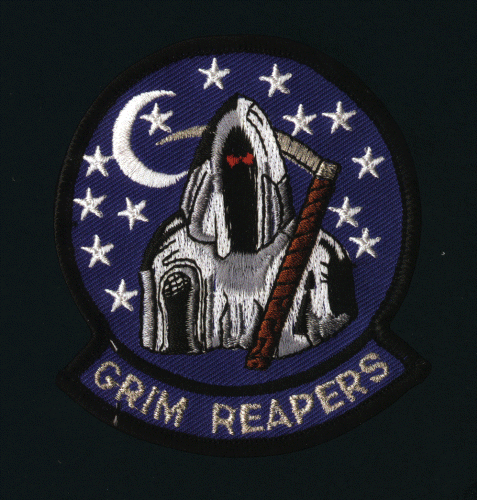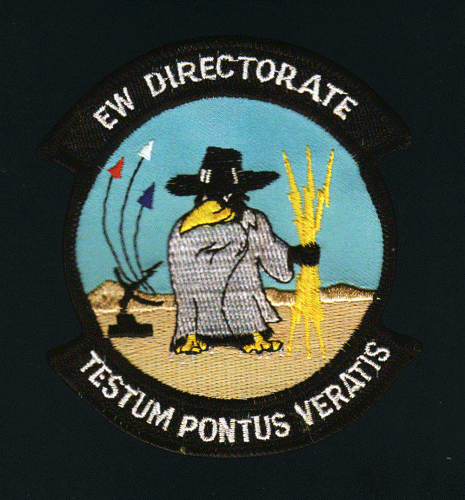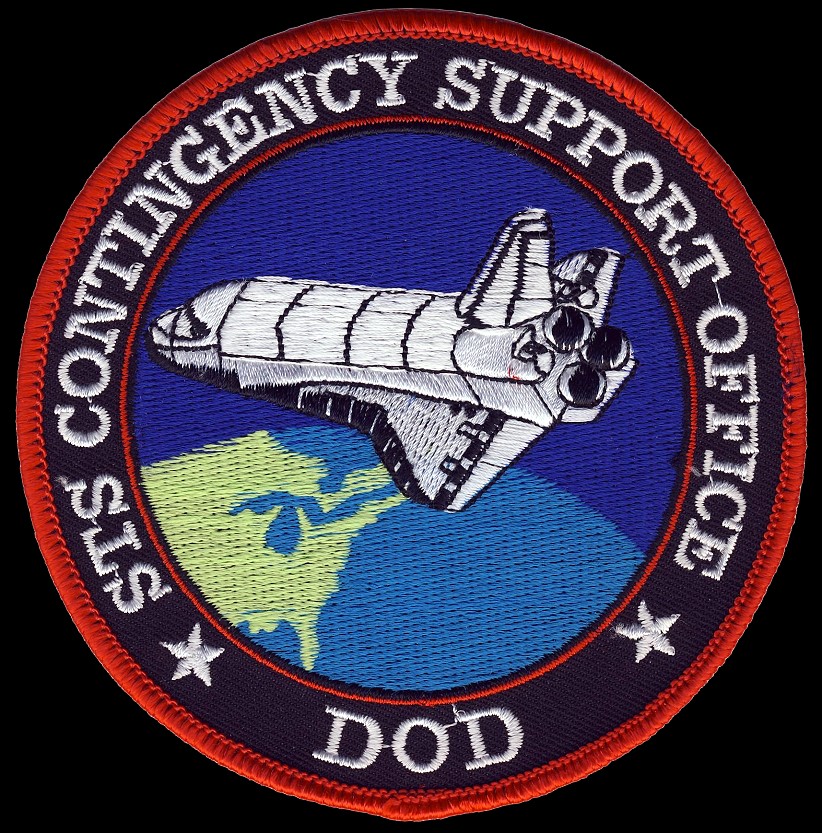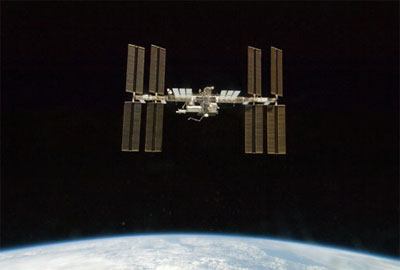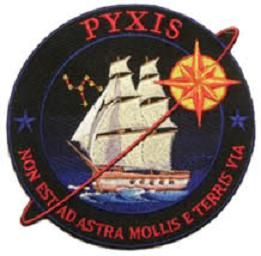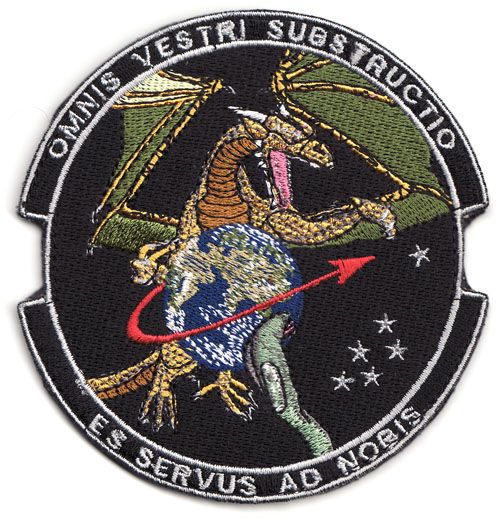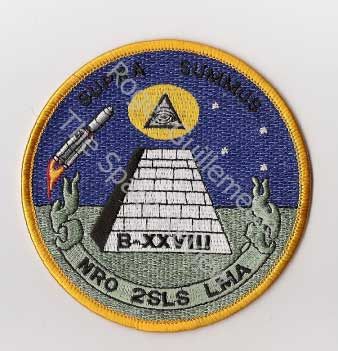
NAVAL SPACE COMMAND
Overview
Naval Space Command's headquarters staff and operational element numbers approximately 350 Navy military and civilian personnel. Their component commands include the Naval Satellite Operations Center and the Fleet Surveillance Support Command.
Naval Space Command, a component of USSPACECOM, operates assigned space systems to provide surveillance and warning, and provides spacecraft telemetry and on-orbit engineering support. In addition, Naval Space Command serves as the Alternate Space Control Center [AASC] for USSPACECOM's primary centers located at Cheyenne Mountain AS.
ASCC missions include operational direction of the entire global space surveillance network (SSN) for commander in chief, USSPACECOM (USCINCSPACE). The ASCC also detects, tracks, identifies, and catalogs all man-made objects in space and provides position information on these objects to about 1,000 customers. In addition, ASCC is charged with monitoring the space environment and informing owners and operators of U.S. and allied space systems of potential threats to their assets by continuous liaison with the systems' operations centers.
The heartbeat of Naval Space Command revolves around providing space support to day-to-day operations of the Fleet and Fleet Marine Forces worldwide, whether for routine deployments, exercises, or actions in response to a crisis situation. This space support to terrestrial and naval forces can be categorized across a broad spectrum of activities that encompass communications, surveillance and indication, and warning, intelligence, navigation, and remote sensing.
[edit]Surveillance
A constant and vigilant surveillance of potentially hostile military threats is critical in preserving the operational effectiveness of our armed forces around the world. Naval Space Command manages two distinct surveillance efforts in support of Fleet and Fleet Marine Forces: tracking satellites in orbit and monitoring over-the-horizon threats from sea and air forces.
First, Naval Space Command operates a surveillance network of nine field stations located across the southern U.S. Three transmitter sites in the network are located at Jordan Lake, Ala., Lake Kickapoo, Texas, and Gila River, Ariz. Six receiver sites are located at Tattnall, Ga., Hawkinsville, Ga., Silver Lake, Miss., Red River, Ark., Elephant Butte, N.M., and San Diego, Calif.
These surveillance stations produce a "fence" of electromagnetic energy that can detect objects out to an effective range of 15,000 nautical miles.
Over one million satellite detections, or observations, are collected by this surveillance network each month. Data gathered is transmitted to a computer center at Naval Space Command headquarters in Dahlgren, where it is used to constantly update a data base of spacecraft orbital elements. This information is reported to Fleet and Fleet Marine Forces to alert them when particular satellites of interest are overhead. The command also maintains a catalog of all earth-orbiting satellites and supports USSPACECOM as part of the nation's worldwide Space Surveillance Network...
Naval Space Command provides space intelligence support to deployed naval forces through an initiative dubbed "Chambered Round." The Chambered Round product is a message that provides deployed naval forces with tactical assessments of hostile space capabilities and specific reactions to their operations. This knowledge assists Fleet and Fleet Marine Force tactical units in reducing their vulnerability to space reconnaissance efforts...
http://www.spacecom.af.mil/usspace/fbnavspa.htm
The Minitrack system that was developed in the late 1950s for the NRL Vanguard Satellite Program used the signals emitted by Sputnik and later satellites to determine their positions and orbits. This pioneering tracking system led to the concept of tracking nonradiating, or noncooperative, satellites by signals reflected off them. An experiment using a transmitter in Fort Monmoth, New Jersey and Minitrack receivers demonstrated the concept, and from this experiment a larger and more elaborate system was developed by NRL. This system became known as the Naval Space Surveillance System (NAVSPASUR), which was commissioned as an operational command in 1961. Although the operational command is now integrated with the Naval Space Command, the sensor system is still in active use as a major component of the North American Aerospace Defense Command (NORAD), and has become the alternate Space Defense Computational Facility.
The system concept of NAVSPASUR is that of a continuous wave (CW) multistatic radar. A high-powered transmitter generates a large fan beam of energy, commonly called the "fence," which reflects signals from an orbiting object back to separate receiving stations. These receiving stations use large arrays of antennas as an interferometer to determine the angle and angle rates of arrival from the reflected signals. By observing the target satellite from several stations, the position can be determined; using multiple penetrations, the orbit can be inferred. This rather simple concept led to a highly reliable system that could detect virtually any satellite coming within the transmitter's illuminated field.
Even though the NAVSPASUR system performs the functions of detection and satellite orbit determination very well, there are limitations on coverage and time required to determine an orbit with the CW fence approach. NRL experiments into methods of improving the system included the idea of transmitting ranging signals as well as the primary CW signal, so that not only could the angles at the receiving sites be measured, but the distance to the target satellite as well (*). An experimental parallel fence with a ranging capability was begun in South Texas in 1960 to demonstrate system performance and early orbit determination. The three stations built in South Texas were a transmitter and two receiving stations...
The U.S. Navy Spasur (Space Surveillance) System is a CW fence radar consisting of a chain of stations located on an east-west great-circle path across the southern United States. Three transmitter stations (one high-powered in the center of the chain and two low-powered on the ends for gap filling) and six receiving stations are used in the network. The system originally operated at 108 MHz [the Minitrack frequency] but was converted to 216 MHz in 1965, along with upgrading and expansion of the original experimental network.
The high-power transmitter consists of two 500-kW transmitters operating in parallel and feeding a north-south linear array 10,560 feet long.
The receiving stations are equipped with a number of linear antenna arrays for phase sensing and alerting. The north-south length of the phase-sensing antennas at two of the sites is 2,400 ft, and the east-west baseline (which sets the angular-accuracy limit) is 1,200 ft or approximately 260 wavelengths. Angular measurements from the various receiving sites are transmitted to a central computer facility located at Dahlgren, Va.
Control and Computation [General requirements for CW fence radars]
Since angle measurements from at least two receiver stations are needed to determine position and to eliminate false alarms due to meteors or aircraft, the outputs must be collected at a central point and processed… One detection (encoded in digital form) requires a total of less than 100 bits. One telephone line from a receiving station to a central control could easily handle 70 or more detections per minute, a rate much higher than would be expected from any foreseeable space population.
The computation requirements for correlating the various receiver angle measurements and providing a detection report are relatively modest. Even [if orbital elements for new detections must be generated and correlated with objects in a catalog].. these computing requirements are well within the capability of a computer of the size of the IBM 7090 for space populations of a few thousand objects.
HISTORY
The naval services' growing dependence on space prompted the Secretary of the Navy to establish a new command that would consolidate space activities and organizations that operate and maintain naval space systems. This new organization - the Naval Space Command - was commissioned on October 1, 1983. It was a decisive move to bring together several activities under a single command to strengthen operational control, provide a central focal point for naval space matters, and more effectively guide future operational uses of space.
MISSION
Naval Space Command uses the medium of space and its potential to provide essential information and capabilities to ashore and afloat naval forces by:
Operating surveillance, navigation, communication, environmental, and information systems;
Advocating naval warfighting requirements in the joint arena; and
Advising, supporting, and assisting naval services through training and by developing space plans, programs, budgets, policies, concepts and doctrine.
As an Echelon 2 command, Naval Space Command reports directly to the Director of Space and Electronic Warfare (N-6) and the Director of Naval Warfare (N-7). Our tasking to support Marine Corps forces comes through the staff of the Commandant of the Marine Corps. In addition, Fleet commanders-in-chief are authorized a direct line of communication with the command for requesting specific operational support.
Naval Space Command also serves as the naval service component of the United States Space Command (USSPACECOM), established in 1985. Component responsibilities include operating assigned space systems to provide surveillance and warning, as well as providing spacecraft telemetry and on-orbit engineering support.
In addition, Naval Space Command provides facilities for and staffs a command center 24 hours a day to serve as the Alternate Space Control Center for U.S. Space Command's primary center located at Cheyenne Mountain Air Station, Colorado.
The Alternate Space Control Center missions include operational direction of the entire global Space Surveillance Network for Commander-in-Chief Space (CINCSPACE). The Center also detects, tracks, identifies, and catalogs all manmade objects in space and provides ephemerides on these objects to about 1,000 customers; and monitors the space environment and informs owners and operators of U.S. and allied space systems of potential threat to their assets by continuous liaison with the systems' operations centers.
Finally, Naval Space Command provides administrative oversight for two Echelon 3 operational Navy activities: the Naval Satellite Operations Center and the Fleet Surveillance Support Command.
FORCE ENHANCEMENT
The heartbeat of Naval Space Command revolves around providing space support to day-to-day operations of the Fleet and Fleet Marine Forces worldwide, whether for routine deployments, exercises, or actions in response to a crisis situation. This space support to terrestrial forces can be categorized across a broad spectrum of activities that encompass communications, surveillance and indication and warning, intelligence, navigation, and remote sensing.
Communications
Naval Space Command is the system operational manager for Navy space-based communications systems, including the Fleet Satellite Communications System, Leased Satellite, and UHF Follow-On.
Fleet Satellite provides worldwide ultra-high-frequency communications between naval aircraft, ships, submarines, ground stations, the U.S. Strategic Command, and national command authorities. The Fleet Satellite system, first operational in 1978, features spacecraft placed geostationary orbits around the equator. A satellite in this type of orbit matches the Earth's rotation in order to remain in roughly the same position over a specific area of the globe. A minimum of four satellites spaced equidistant around the globe provides worldwide coverage.
Leased Satellite spacecraft, which also provides Ultra-High Frequency communications, were first launched in 1984 to augment the Fleet Satellite system. This Ultra-High Frequency constellation also features three satellites deployed in roughly the same positions as the Fleet Satellite spacecraft.
To further enhance satellite communications capabilities for the future, Naval Space Command manages a joint-service project that has placed extremely-high-frequency communications test modules into orbit. Carried into space aboard Fleet Satellite spacecraft in 1987 and 1989, these experimental Fleet Satellite Extremely-High Frequency Packages are providing our naval forces with limited operational capability at Extremely-High Frequency and are enabling them to test new Extremely-High Frequency terminals being developed for a future military satellite system intended to provide a more survivable, jam-resistant communications capability.
Naval Space Command also manages a new generation of Ultra-High Frequency communications satellites now being launched to replace Fleet Satellite and Leased Satellite systems, which are nearing the end of their operational lives. The Ultra-High Frequency Follow-On spacecraft are designed for a 14-year lifetime and will be compatible with ground-based and sea-based communications terminals already in service. The new satellites will use the same frequency spectrum as the current constellation of Ultra-High Frequency satellites, but will have additional transmitters to provide an increase in communications capacity.
Midway through the program, Ultra-High Frequency Follow-On incorporates an Extremely-High Frequency communications payload. The Extremely-High Frequency package will provide enhanced anti-jam telemetry, command, broadcast, and Fleet interconnectivity communications. This payload will be on all subsequent Ultra-High Frequency Follow-On satellites.
Each spacecraft features solid-state Ultra-High Frequency amplifiers and provides multiple Ultra-High Frequency channels. These frequencies consist of narrow-band channels, relay channels, and broadcast channels. Newer satellites also have Extremely-High Frequency capabilities.
The Extremely-High Frequency packages on the Ultra-High Frequency Follow-On-4 and subsequent spacecraft in the series constitute an additional 11 channels distributed between an Earth coverage beam and a steerable 5-degree spot beam.
Additionally, Naval Space Command coordinates Navy use of and requirements for the Defense Satellite Communications System. This satellite system includes four spacecraft in geosynchronous orbit that provides worldwide communications at super-high-frequency for U.S. and allied forces.
Surveillance
A constant and vigilant surveillance of potentially hostile military threats is critical in preserving the operational effectiveness of our armed forces around the world. Naval Space Command manages two distinct surveillance efforts in support of Fleet and Fleet Marine Forces - tracking satellites in orbit and monitoring over-the-horizon threats from sea and air forces.
First, Naval Space Command operates a surveillance network of nine field stations located across the southern U.S. Three transmitter sites in the network are located at Jordan Lake, Alabama; Lake Kickapoo, Texas; and Gila River, Arizona. Six receiver sites are located at Tattnal, Georgia; Hawkinsville, Georgia; Silver Lake, Mississippi; Red River, Arkansas; Elephant Butte, New Mexico and San Diego, California. These surveillance stations produce a "fence" of electromagnetic energy that can detect objects to an effective range of 15,000 nautical miles.
Over one million satellite detections, or observations are collected by this surveillance network each month. Data gathered is transmitted to a computer center at Naval Space Command headquarters in Dahlgren, Virginia, where it is used to constantly update a data base of spacecraft orbital elements. This information is reported to Fleet and Fleet Marine Forces to alert them when particular satellites of interest are overhead. The command also maintain a catalog of all Earth-orbiting satellites and supports USSPACECOM as part of the nation's worldwide Space Surveillance Network.
A second surveillance effort, devoted to over-the-horizon threats, is carried out by the Fleet Surveillance Support Command. Established in 1987, this organization's mission is to operate and maintain the Navy's Relocatable Over-the-Horizon Radar systems. It is a high-frequency, land-based radar that provides wide-area oceanic surface and air surveillance data to support the Fleet. The systems can detect and track ships and aircraft in fixed sectors with ranges in excess of 1,000 nautical miles. Detachments of the command directly support Fleet commanders-in-chief who exercise operational control of the deployed systems.
Intelligence
Naval Space Command provides space intelligence support to deployed naval forces through an initiative dubbed "Chambered Round." The Chambered Round product is a message that provides deployed naval forces with tactical assessments of hostile space capabilities and specific reactions to their operations. This knowledge assists Fleet and Fleet Marine Force tactical units in reducing their vulnerability to space reconnaissance efforts.
Remote Sensing
Naval Space Command provides a multi-spectral imagery from LANDSAT and SPOT Earth resources spacecraft to assist naval forces with exercise and strike planning, provide updated maps and charts, and enhance intelligence and surveillance capabilities. The command has provided multi-spectral imagery products to U.S. warfighters in support of recent operations in Southwest Asia, Somalia, Haiti, Yugoslavia, and Korea.
Current as of June 1995
http://www.au.af.mil/au/awc/awcgate/usspc-fs/navspace.htm
NAVY Space Command Uncovered
Naval Space Command
A Pegasus Presentation
It is our contention that the US NAVY is in charge despite the existence of the USAF Space Command, just like in Star Trek it is the NAVY that commands the space fleet...
Gary McKinnon's claim to 'fame' is NOT that he found UFO's or UFO 'free energy' technology, his only claim is he saw a picture of one of those space fleet ships... and found a list of 'non terrestrial' officers... these were NOT ET, but billets in space by OUR armed forces...
The Movie - Space Flight: Application of Orbital Mechanics
AVA18245VNB1 - 1994
In the opening credits the Naval Space Command is listed ABOVE NASA. The US NAVY runs the real space program and NASA is just a pretty front for the public.
This video details planetary motion or orbital mechanics. It explains Kepler's and Newton's Laws plus terminology including perigee, apogee, eccentricity, orbital inclination, launch window, etc.

As to Gary McKinnon's Space Ship and Non Terrestrial Officers...
His biggest mistake was going in the back door.
So as to the Space Ship or Fleet...
In an Air Force Space Commands Press Release... After the point of contact... there is an interesting reference...
History
Missile warning and space operations were combined to form Air Force Space Command in 1982. During the Cold War, space operations focused on missile warning, and command and control for national leadership. In 1991, Operation Desert Storm provided emphasis for the command's new focus on support to the warfighter. ICBM forces were merged into AFSPC in 1993.
Point of contact
Air Force Space Command
Public Affairs Office
150 Vandenberg St., Suite 1105
Peterson AFB, CO 80914-4500
(719) xxx-xxxx or DSN 692-3731
In Popular Culture
In the popular TV series Stargate SG-1 and Stargate Atlantis, the Stargate Program is run by the Air Force Space Command. The AF Space Command Patch was worn on the uniform of personnel aboard the Prometheus, Earth's first operational deep space battle cruiser.
This flier has since been upgrade to a more recent one but the quote is still copied on Wikipedia
"As to the those Non-Terrestrial Officers
I subscribe to a hard copy magazine from Space Command... "
High Frontier
The Journal for Space and Missile Professionals
In the Summer 2004 issue there is this notice...
Space Command
General Kevin P. Chilton
Commander, Air Force Space Command
"The establishment of Space Command is a crucial milestone in the evolution of military space operations. Space is a place--like land, sea, and air--a theater of operations. And it was just a matter of time until space was treated as such." ~ General James V. Hartinger, 1 September 1982
Naval Space Command
Beginning in the mid-1980s, concurrent with the development of space operations and space engineering curricula at the Naval Postgraduate School, the Navy began “coding” officers as space subspecialists. As space subspecialty codes were then assigned to particular officers’ billets on numbered Fleet staffs and at commands ashore, the service began assigning Navy members with matching codes to those positions. More recently, the Navy has begun efforts to build a cadre of “space smart” officers, enlisted personnel and civilian employees.
The Naval Space Cadre is composed of active-duty and reserve Navy and Marine Corps officers and enlisted personnel, along with Navy civilian employees from a wide range of career fields who meet mandatory education, training and experience standards established for a particular certification level. The Navy Space Cadre is a distinct body of expertise horizontally and vertically integrated within Navy and Marine Corps active duty, reserves and civilian employee communities organized to
operationalize space
Initial identification of the cadre began in mid-2001 with the standup of the Naval Space Cadre Working Group and culminated in a naval message (NAVADMIN 201/03 DTG211435Z JUL 03) announcing the first 700 officer members of the cadre. These officers were identified by the subspecialty codes of 6206, Space Systems Operations, and 5500, Space Systems Engineering or by the additional qualification designator of VS1, VS2, VS3 or VS4. Identification of enlisted and civilian cadre members is more challenging, as these groups do not have specif?ic space identifiers like the officers do.
Approximately 265 billets are currently identified as space billets. These jobs are in Navy, joint and National Security Space organizations. Space cadre members are currently assigned throughout the National Security Space arena, including the National Reconnaissance Office, National Security Space Architect, National Security Space Integration, MILSATCOM Joint Program Office, as well as in all Navy organizations that deal with space.
High Frontier
The Journal for Space and Missile Professionals
Summer 2004
There is no online copy available but a PDF copy is available to serious enquiries.
So there we have it...
...first 700 officer members of the cadre, identified by the subspecialty codes of 6206, Space Systems Operations, and 5500, Space Systems Engineering... with 265 billets currently identified as space billets. These jobs are in Navy...
See PBS NOVA Astrospies...
http://www.pbs.org/wgbh/nova/astrospies/
Pegasus page on this is HERE
http://www.thelivingmoon.com/47john_lear/02files/Secret_Astronauts_Astrospies.html
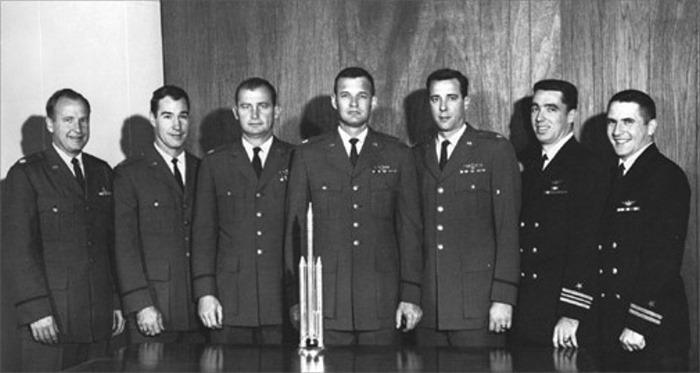
They were the "Magnificent Seven" of the Manned Orbiting Laboratory program, some of the best pilots the U.S. military had to offer the officials who were making the first MOL crew selection in 1965. Two more crews would follow, including that of Bob Lawrence, the first African-American astronaut. These men, 17 in all, were set to make history in space as the first military astronauts, performing covert reconnaissance from orbit. Yet while NASA's astronauts were gracing magazine covers and signing autographs, the MOL teams were sworn to secrecy; most of the program's details remain classified even today. And MOL was canceled in 1969, before any of its astronauts went into space. To learn more about some of these secret astronauts and their subsequent career achievements, [see below].—Rima Chaddha
Note:
While all 17 MOL astronauts deserve equal acknowledgement, we chose to focus on the first crew as well as on the one member whose status as an astronaut went unacknowledged for 30 years. The full MOL roster is as follows:
MOL Group 1: Formed November 1965
Michael J. Adams (Air Force, left MOL shortly after selection)
Albert H. Crews Jr. (Air Force)
John L. Finley (Navy, left MOL prior to the program's cancellation)
Richard E. Lawyer (Air Force)
Lachlan Macleay (Air Force)
Francis G. Neubeck (Air Force)
James M. Taylor (Air Force)
Richard H. Truly (Navy)
MOL Group 2: Formed June 1966
Karol J. Bobko (Air Force)
Robert L. Crippen (Navy)
Charles G. Fullerton (Air Force)
Henry W. Hartsfield Jr. (Air Force)
Robert F. Overmyer (Marine Corps)
MOL Group 3: Formed June 1967
James A. Abrahamson (Air Force)
Robert T. Herres (Air Force)
Robert H. Lawrence Jr. (Air Force)
Donald H. Peterson (Air Force)
"For a long time now we at Pegasus have been telling people that there was, and is a corp of Astronauts who are not connected to NASA and fly secret missions. It has always been our contention that this "Secret Astronaut Corp" not only exists, but is far more active currently in space, on the Moon and on Mars...
Naturally we are told we are crazy... there is no way they could hide this... and of course as with any truly secret program, there is really no way to prove our position... The best we can do is hunt circumstantial evidence and present our case... Then things started to happen..."
First there was GARY McKINNON, a British hacker who claime he accessed NASA files via open passwords... He stated in an interview...
"What was the most exciting thing you saw?" I ask.
"I found a list of officers' names," he claims, "under the heading 'Non-Terrestrial Officers'."
"Non-Terrestrial Officers?" I say.
"Yeah, I looked it up," says Gary, "and it's nowhere. It doesn't mean little green men. What I think it means is not earth-based. I found a list of 'fleet-to-fleet transfers', and a list of ship names. I looked them up. They weren't US navy ships. What I saw made me believe they have some kind of spaceship, off-planet."
"The Americans have a secret spaceship?" I ask.
"That's what this trickle of evidence has led me to believe."
"Some kind of other Mir that nobody knows about?"
"I guess so," says Gary.
"What were the ship names?"
"I can't remember," says Gary.
Now unfortunately he does not have any evidence to back this up, but the action taken against him does seem to indicate he had indeed found something 'sensitive'. So this is just one more bit of circumstantial evidence...
Gary McKinnon has been accused of committing the 'biggest military computer hack of all time', and if extradited to the US faces up to 70 years in jail. So how did this techno geek from north London end up cracking open the Pentagon and Nasa's systems? He talks exclusively to Jon Ronson as he awaits his fate. His case is still in the legal system today - see Gary McKinnon
http://www.pbs.org/wgbh/nova/astrospies/
http://www.thelivingmoon.com/47john_lear/02files/Secret_Astronauts_Astrospies.html
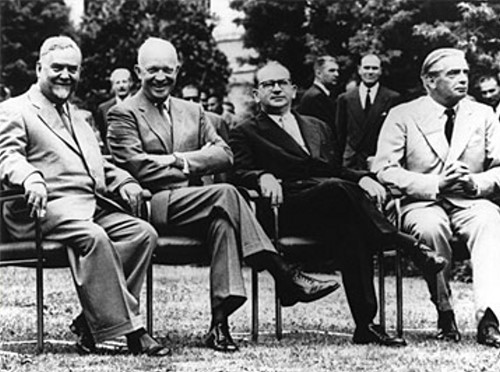
1955 - The Meeting
Following World War II, the United States and the Soviet Union entered into the Cold War game of spy-versus-spy that ultimately led to the space race. Americans were still deeply unsettled by the 1941 attack on Pearl Harbor, and the U.S. government wanted to arrange flyovers of U.S.S.R. territory to learn what they could about Soviet arms. Equally, the Soviets wanted to spy on the United States but strived to keep their depleted military resources secret. In July 1955, President Dwight Eisenhower proposed an "Open Skies" policy whereby either nation would be allowed to fly reconnaissance aircraft over the other. When the Soviet Union rejected the proposal, Eisenhower sought other ways to gather intelligence. On July 29, he announced that the United States would begin work on a scientific satellite. The Soviet Union immediately announced that it too would launch a satellite.
http://www.pbs.org/wgbh/nova/astrospies/time-nf.html
On Star Wars...
Q: Can you update us on... The colonel mentioned that by the time he got to the office in 1989 it was pretty clear the U.S. wasn't going to deploy a space-based missile defense system. What's happened to the Star Wars program? How is your office changing? What are you using this technology for today?
A: Although many of the space platforms that were really envisioned as part of the Strategic Defense Initiative Organization program back in 1989 have not been supported and continued because of the change in emphasis, including the name of the organization to the Ballistic Missile Defense Organization, we're now primarily focused on theater missile defense and national missile defense -- defense of the U.S. continent and Alaska and Hawaii with a much reduced threat. And of course we have the demise of the Cold War to thank for that.
However, there is still a space-borne component to our theater and national missile defense architecture, and that is the space-based infrared satellite. That will allow us to do tracking, particularly in boost and in the mid-course phases of the trajectory of a ballistic missile. So all the technologies that were demonstrated on Clementine are technologies that we would hope would be either used or would be the grand-daddies of technologies that we would eventually use in our space surveillance platforms. So that part of the space architecture is still very much alive.
Q: But the role of the so-called Star Wars system now has shifted to more of a surveillance, as opposed to shooting something down...
A: No, it is still based on shooting down ballistic missiles by impact with interceptors. So this technology is important in order to track and pass the track files on to the interceptors in order to allow them to hit their targets. So it's very much a part of the architecture.
On Water Ice...
Q: That translates to what in volume?
A: We were very conservative in the press release, but if you take basically 100 square kilometers by roughly 50 feet, you get a volume of something like a quarter of a cubic mile, I think it's on that order. It's a considerable amount, but it's not a huge glacier or anything like that.
Q: Can you compare that with something you know?
A: It's a lake. A small lake.
On Wherefore Art Though Clementine...
The Clementine spacecraft has many mysteries surrounding it, but the name sake... where is Clementine? Lost and gone forever? Well not quite...
Here is our work on Clementine...
Wherefore Art Thou Clementine? - The Mystery of Clementine Explored
http://www.thelivingmoon.com/43ancients/41Group_Lunar_FYEO/02files/FYEO_Clementine_01.html
Q: Where is Clementine now?
A: The spacecraft, as you know, from the name Clementine, is only supposed to be here for a short period of time and be lost and gone forever, so it was intended for a very short period of time after this lunar mission, did a rendezvous with the earth, and shortly after that was shifted by the moon's
gravity and continued a flight which will bring it back near the earth about nine years from now. So it's an 11 year total flight around the sun. So basically it's moving like a little planet around the sun, and it will bring it back close to us in about nine years... It's two years since it left us so it will be another nine years before it's back. But it's not useful right now. The mission is finished.
Q: But unlike it's namesake, it's not lost and gone forever. It will be back?
A: It will be back, but it's not a useful spacecraft any more.
The above quotes are from the Pentagon Press Release issued in 1996 but not online till Oct 2006
DoD News Briefing
Presenter: Dr. Dwight Duston, Assistant Deputy for Technology, Ballistic Missile Defense Organization;
http://www.defense.gov/transcripts/transcript.aspx?transcriptid=731
to be continued...
Last edited by Carol on Tue Nov 01, 2011 9:16 am; edited 1 time in total














